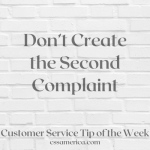
Our interactions with customers are “Moments of Truth.” These Moments of Truth can be conversations with a customer about some complaint, encounters when they’re in the drive-thru, questions about an order that the customer calls in to the company, or brief interactions in the lobby of a government building.
Sometimes during these interactions, there are waits. At the fast-food restaurant, the employee at the window is waiting for the food to be prepared. In the building lobby, the customer is waiting for the employee to finish paperwork with the previous customer. With the customer calling in about the product they ordered, the wait could be the time it takes for the employee to conduct the research so that they can give the customer the answer.
During these Moments of Truth, the employees are often waiting or doing an activity while the customer is present. Yet, too many employees only communicate with the customer when they need information or they’re wanting to convey information.
So mostly, there’s dead silence.
From the customer’s perspective, silence can mean that there’s an issue, that the employee has forgotten the customer, that staff don’t care. And that just makes the wait feel longer, and the customer’s emotions can more easily go negative.
Employees need to view these periods of silence as relationship building opportunities. While the research is being done or the wait is underway, the employee can simply say nothing and create a cold, impersonal experience for the customer, or the employee could engage the customer. During the wait, the employee could talk to the customer about their situation or describe what is being done. The employee could use these times of waiting and research to build relationships.
The next time you’re with the customer and the conversation stalls during a wait or some other activity that is going on, use that time to keep the communication going to build your organization’s relationship with the customer.
View waits as opportunities to build relationships.
Signup for FREE Tips! Contact Us More Resources for You Visit Our Home Page














 The customer was throwing an absolute fit in the lobby. Sitting among several other customers waiting for her number to be called, she was raising her voice and letting out the occasional expletive about the lengthy wait time. An employee sitting behind the counter thought to herself: I’m going to ignore her and not make eye contact and hope somebody else deals with her.
The customer was throwing an absolute fit in the lobby. Sitting among several other customers waiting for her number to be called, she was raising her voice and letting out the occasional expletive about the lengthy wait time. An employee sitting behind the counter thought to herself: I’m going to ignore her and not make eye contact and hope somebody else deals with her.







